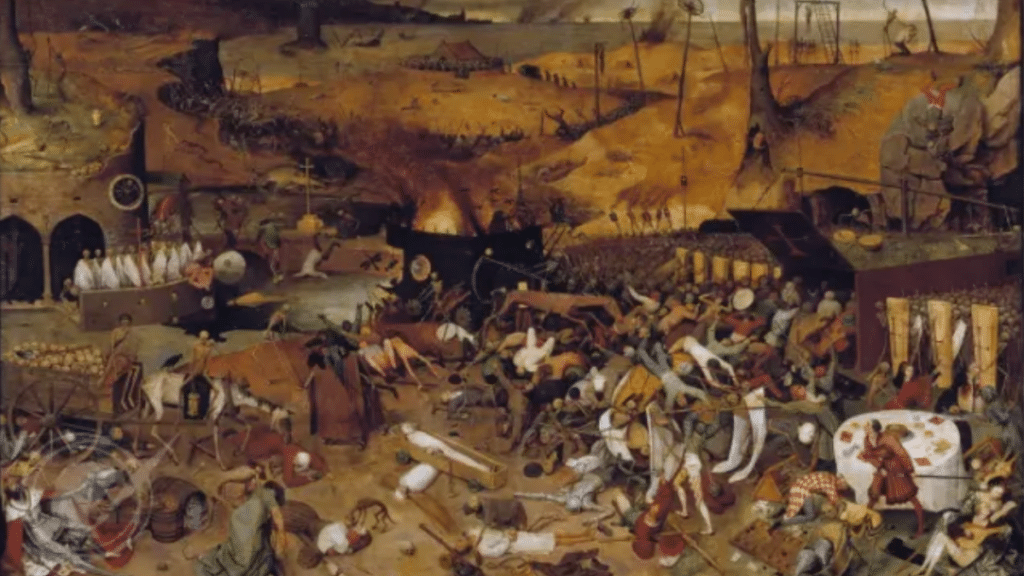Throughout history, the subject of death has been a profound source of inspiration for artists across various cultures and eras. This fascination has given rise to a unique genre in the art world: death paintings. These artworks are not merely morbid depictions; they are complex narratives that explore the philosophical, religious, and societal implications of mortality. This article delves into the world of death paintings, exploring their origins, evolution, and impact on the art world.
The genesis of death paintings can be traced back to medieval Europe, where the omnipresence of death due to plagues and wars influenced artistic expression. These early works were often religious in nature, portraying death as a gateway to the afterlife. They served as visual reminders of the transient nature of life and the inevitability of death.
One of the most iconic symbols from this era is the ‘Danse Macabre’ or ‘Dance of Death’. This motif depicted skeletons or the personification of death leading people from all walks of life in a final dance. The message was clear: death is the great equalizer, sparing no one regardless of their status or wealth.
As the Renaissance unfolded, the depiction of death in art underwent a transformation. Artists began to explore death through a more humanistic lens, reflecting the era’s intellectual and cultural awakening. This period saw a blend of the macabre with classical beauty, creating a juxtaposition that emphasized the fragility of life.
The Baroque period furthered this exploration, with artists like Caravaggio employing dramatic lighting and realism to convey the raw emotion and gravity of death. These paintings often carried moral or religious messages, using death as a tool to remind viewers of virtuous living.
The 17th century brought a new dimension to death paintings with the advent of vanitas art. These works were still lifes that included symbolic objects like skulls, wilting flowers, and hourglasses, representing the futility and vanity of earthly pleasures and achievements in the face of death.
In the 19th century, the Romantic movement gave rise to a different portrayal of death. Artists like Henry Fuseli and Francisco Goya depicted death in a more emotional and personal context, often intertwined with themes of tragedy, love, and existential despair.
The Victorian era had a particular obsession with death, influenced by high mortality rates and mourning practices. This obsession was reflected in art through elaborate funerary scenes and post-mortem photography, which were considered a normal part of grieving.
One artist who profoundly influenced the depiction of death in art was Pieter Bruegel the Elder. A Flemish Renaissance painter, Bruegel’s works are renowned for their vivid, detailed, and often bustling scenes of peasant life. However, he also ventured into the realm of death paintings, with his most notable contribution being the “Triumph of Death” painting. This masterpiece is a stark, harrowing portrayal of death’s indiscriminate rampage over humanity.
“The Triumph of Death” by Bruegel is a panoramic landscape of chaos and despair, where an army of skeletons wreaks havoc across a desolate land. This painting stands out for its detailed imagery and Bruegel’s ability to capture the essence of death’s universal and unyielding nature. It serves as a powerful memento mori, reminding viewers of life’s fragility and the inescapability of death.
Moving into the 20th century, the depiction of death in art became more abstract and symbolic, reflecting the complexities of modern life and the existential crises of the time. Artists like Edvard Munch and Salvador Dalí infused their personal fears and anxieties into their works, creating haunting images that resonated with the existential dread of the era.
Contemporary death paintings have continued to evolve, with artists using a variety of mediums and styles to explore the theme. These works often challenge conventional views of death, offering fresh perspectives and interpretations.
Today, death paintings are not only seen in galleries and museums but have also permeated popular culture. They appear in film, television, and digital media, showcasing the enduring fascination with this theme.
The impact of death paintings extends beyond their aesthetic value. They serve as a means for societies to confront and understand their relationship with death. Through these artworks, viewers are invited to reflect on their own mortality and the transient nature of human existence.
Despite their somber subject matter, death paintings are not always about despair. Many artists use them to celebrate life and its impermanence, creating a sense of urgency to cherish each moment.
The fascination with death in art also reflects the human need to find meaning and solace in the face of our inevitable end. These artworks often provide comfort, offering different cultural and spiritual perspectives on death and the afterlife.
The diversity of death paintings showcases the multifaceted nature of how cultures and individuals perceive death. From the stark realism of Renaissance works to the abstract expressions of contemporary art, these paintings are a testament to the complex relationship humanity has with death.
As we continue to explore the depths of human experience through art, death paintings remain a significant and powerful genre. They challenge us to confront our fears, question our beliefs, and ultimately, understand our place in the world.
In conclusion, death paintings are not merely morbid curiosities but are profound artistic expressions that capture the essence of the human condition. They remind us of our mortality, provoke thought about the meaning of life and death, and continue to inspire and move viewers across generations.

